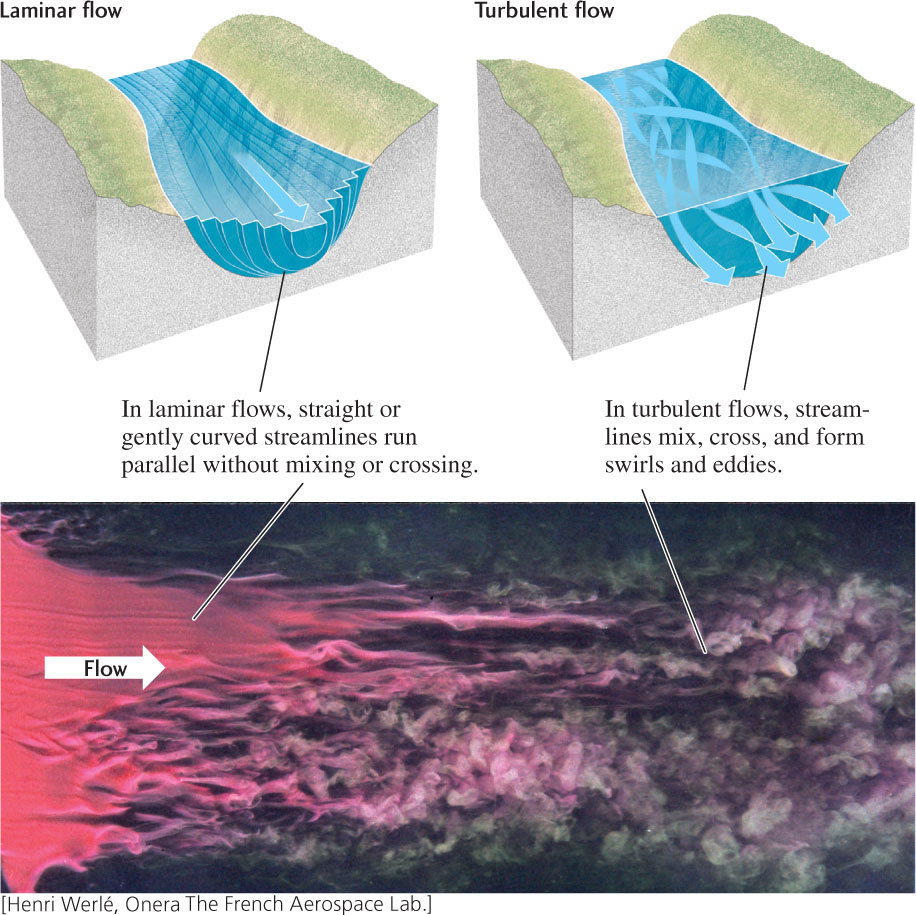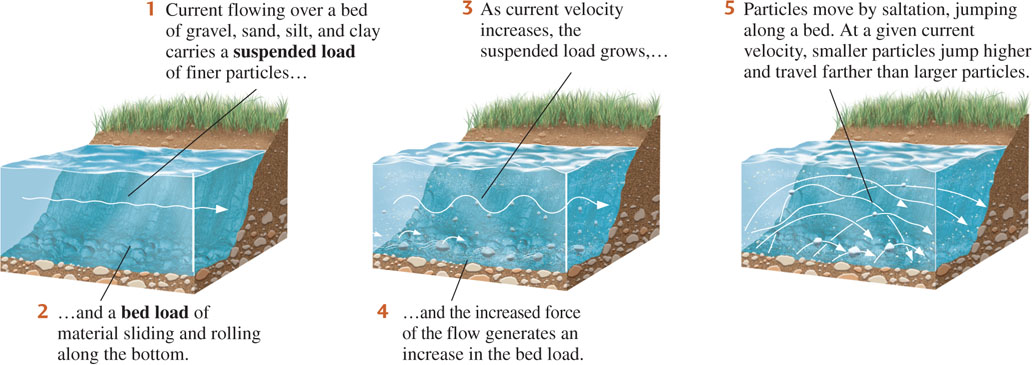How Currents Flow and Transport Sediment
All currents, whether in water or in air, share the basic characteristics of fluid flow. We can illustrate two kinds of fluid flow by using lines of motion called streamlines (Figure 18.14). In laminar flow, the simplest kind of fluid movement, straight or gently curved streamlines run parallel to one another without mixing or crossing between layers. The slow movement of thick syrup over a pancake, with strands of unmixed melted butter flowing in parallel but separate paths, is a laminar flow. Turbulent flow has a more complex pattern of movement, in which streamlines mix, cross, and form swirls and eddies. Fast-moving stream waters typically show this kind of motion. Turbulence—the degree to which there are irregularities and eddies in the flow—may be low or high.

Whether a fluid flow is laminar or turbulent depends primarily on three factors:
- 1. Its velocity (rate of movement)
- 2. Its geometry (primarily its depth)
- 3. Its viscosity (resistance to flow)
Viscosity arises from the attractive forces between the molecules of a fluid. These forces tend to impede the slipping and sliding of molecules past one another. The greater the attractive forces, the greater the resistance to mixing with neighboring molecules, and the higher the viscosity. For example, when cold syrup or viscous cooking oil is poured, its flow is sluggish and laminar. The viscosity of most fluids, including water, decreases as their temperature increases. Given enough heat, a fluid’s viscosity may decrease sufficiently to change a laminar flow into a turbulent one.
Water has low viscosity in the range of temperatures found at Earth’s surface. For this reason alone, most streams in nature tend toward turbulent flow. In addition, the velocity and geometry of most natural streams make them turbulent. In nature, we are likely to see laminar flows of water only in thin sheets of rain runoff flowing slowly down nearly level slopes. In cities, we may see small laminar flows in street gutters.
510
Because most streams and rivers are broad and deep and flow quickly, their flows are almost always turbulent. A stream may show turbulent flow over much of its width and laminar flow along its edges, where the water is shallower and is moving more slowly. In general, the flow velocity is highest near the center of a stream; where a stream meanders, the flow velocity is highest at the outsides of the bends. We commonly refer to a rapid flow of water as a strong current.
Erosion and Sediment Transport
Currents vary in their ability to erode and carry sand grains and other sediments. Laminar flows of water can lift and carry only the smallest, lightest clay-sized particles. Turbulent flows, depending on their velocity, can move particles ranging in size from clay to pebbles and cobbles. As turbulence lifts particles into a flow, the flow carries them downstream. Turbulence also rolls and slides larger particles along the bottom of the channel. A current’s suspended load includes all the material temporarily or permanently suspended in the flow. Its bed load is the material the current carries along the bed by sliding and rolling (Figure 18.15). The bed, in this context, is the layer of unconsolidated material in the channel that interacts with the current.

The greater the velocity of a current, the larger the particles it can carry as suspended load and bed load. A flow’s ability to carry material of a given particle size is its competence. As current strength increases and coarser particles are suspended, the suspended load grows. At the same time, more of the bed material is in motion, and the bed load also increases. As we would expect, the larger the volume of a flow, the greater the sediment load (suspended load plus bed load) it can carry. The total sediment load carried by a flow is its capacity.
The velocity and the volume of a flow affect both the competence and the capacity of a stream. The Mississippi River, for example, flows at moderate speeds along most of its length and carries only fine to medium-sized particles (clay to sand), but it carries huge quantities of them. A small, steep, fast-flowing mountain stream, in contrast, may carry boulders, but only a few of them.
A current’s suspended load depends on a balance between turbulence, which lifts particles, and the competing downward pull of gravity, which makes them settle out of the current and become part of the bed. The speed with which suspended particles of various weights settle to the bed is called their settling velocity. Small grains of silt and clay are easily lifted into the stream and settle slowly, so they tend to stay in suspension. The settling velocities of larger particles, such as medium- and coarse-grained sand, are much higher. Most larger grains therefore stay suspended in the current only a short time before they settle.
511
As current velocity increases, sediment particles in the bed load begin to move by a third process, known as saltation: an intermittent jumping motion along the bed. Sand grains are most likely to move by saltation because they are light enough to be picked up from the bed, yet heavy enough not to be transported in suspension. The grains are sucked up into the flow by turbulent eddies, move with the current for a short distance, and then fall back to the bed (see Figure 18.15). If you were to stand in a rapidly flowing sandy stream, you might see a cloud of saltating sand grains moving around your ankles. The bigger the grain, the longer it will tend to remain on the bed before it is picked up. Once a large grain is in the current, it will settle quickly. The smaller the grain, the more frequently it will be picked up, the higher it will “jump,” and the longer it will take to settle.
Worldwide, streams carry about 25 billion tons of siliciclastic sediments and an additional 2 billion to 4 billion tons of dissolved matter each year. Humans are responsible for much of the present sediment load. According to some estimates, prehuman sediment transport was about 9 billion tons per year, less than half the present value. In some places, we increase the sediment load of streams through agriculture and accelerated erosion. In other places, we decrease the sediment load by constructing dams, which trap sediment behind them.
To study how a particular stream carries sediments, geologists and hydraulic engineers measure the relationship between particle size and the force the flow exerts on the particles in the suspended and bed loads. This relationship shows them how much sediment a particular flow can move and how rapidly it can move it. That information allows them to design dams and bridges or to estimate how quickly artificial reservoirs behind dams will fill with sediments. As we saw in Chapter 5, geologists can infer the velocities of ancient currents from the sizes of grains in sedimentary rocks.
Figure 18.16 graphs the relationship between the sizes of sediment particles on the streambed and the flow velocities required to erode them. You will notice that in this graph, contrary to our earlier discussion of competence, the current velocity required to erode some kinds of particles from the bed actually increases as particle size decreases. This relationship exists because it is easier for the current to lift noncohesive particles (particles that do not stick together) than cohesive particles (particles that stick together, as many clay minerals do). The finer the cohesive particles, the greater the velocity of the flow required to erode them. Settling velocities for these small particles, however, are so slow that even a gentle current, about 20 cm/s, can keep them in suspension and transport them over long distances.

Sediment Bed Forms: Dunes and Ripples
When a current transports sand grains by saltation, the sand tends to form dunes and ripples (see Chapter 5). Dunes are elongated ridges of sand up to many meters high that form in flows of wind or water over a sandy bed. Ripples are very small dunes—with heights ranging from less than a centimeter to several centimeters—whose long dimension is formed at right angles to the current. Although underwater ripples and dunes produced by water currents are harder to observe than those produced on land by air currents, they form in the same way and are just as common.
512
As a current moves sand grains by saltation, they are eroded from the upstream side of ripples and dunes and deposited on the downstream side. The steady downstream transfer of grains across the ridges causes the ripple and dune forms to migrate downstream. The speed of this migration is much slower than the movement of individual grains and very much slower than the current. (We will look at ripple and dune migration in more detail in Chapter 19.)
The shapes of ripples and dunes and their migration speeds change as the velocity of the current increases. At the lowest current velocities, few grains are saltating, and the sediment bed is flat. At slightly higher velocities, the number of saltating grains increases. A rippled bed forms, and the ripples migrate downstream (Figure 18.17). As the velocity increases further, the ripples grow larger and migrate faster until, at a certain point, dunes replace the ripples. Both ripples and dunes have a cross-bedded structure (see Figure 5.11). As the current flows over their tops, it can actually reverse and flow backward along their downstream side. As the dunes grow larger, small ripples form on them. These ripples tend to climb over the backs of the dunes because they migrate more quickly than the dunes. Very high current velocities will erase the dunes and form a flat bed below a dense cloud of rapidly saltating sand grains. Most of these grains hardly settle to the bottom before they are picked up again. Some are in permanent suspension.

513